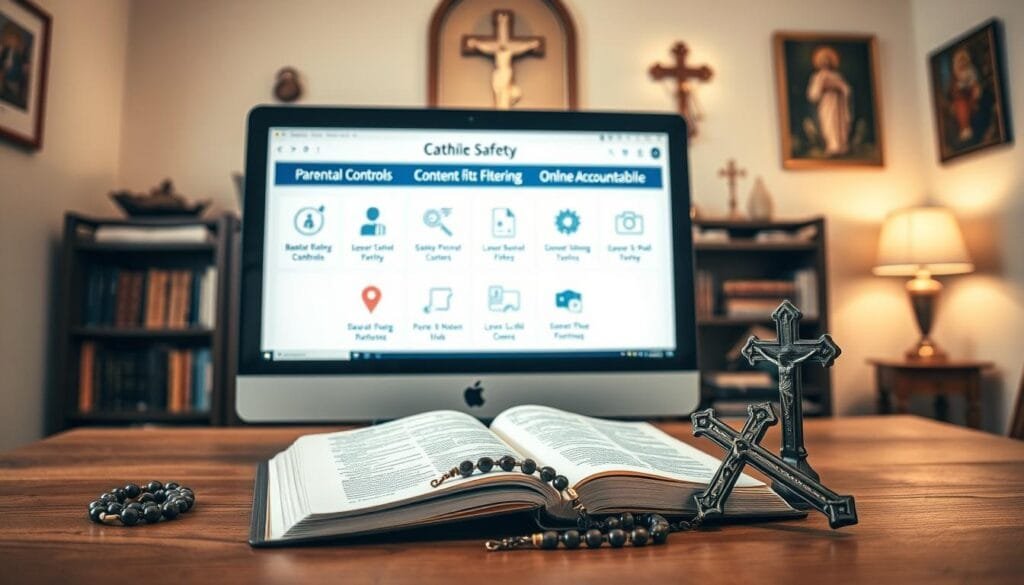Building Stronger Homes Through Catholic Family Social Media
This website contains affiliate links. As an Amazon Associate, I earn from qualifying purchases. The content on this website was created with the help of AI.
Social media often gets a bad reputation for distracting families or pulling us away from what matters most.
However, when used intentionally, it can become a powerful tool for faith and connection.
That’s where Catholic family social media comes in, not as another place to scroll endlessly, but as a way to share values, build community, and witness to the beauty of family life rooted in Christ.
It’s about using the digital world to strengthen our real-world relationships.
Key Takeaways
- Limiting screen time to 30 minutes daily reduced loneliness by 30% in a 2018 study.
- Pope Francis warns against becoming “technology hermits,” disconnected from real relationships.
- The U.S. Council of Catholic Bishops urges respectful dialogue online to protect the vulnerable.
- YouTube is rated healthier for youth than Instagram, per a 1,500-person study.
- Christus Vivit 90 reminds us that digital addiction risks eroding our grasp of reality.
Understanding Social Media Through a Catholic Lens
Exploring how Catholic teachings influence our online lives begins with an examination of Catholic teachings on social media.
The Church teaches that technology should respect human dignity. Pope Francis says that social media can either bring us together or tear us apart, depending on our actions.
Church Teaching on Digital Communication
The Vatican social media guidance tells Catholics to use these platforms wisely.
The Church, through World Communications Day messages, stresses the importance of truth and kindness online.
Archbishop Salvatore Cordileone cautions against getting trapped in online bubbles, encouraging us to seek out different views.
Balancing Technology and Faith Life
Controlling our screen time is a conscious choice. With most adults on Facebook and quick post views, families can set limits:
- Make time for prayer or meals without screens
- Choose content that inspires, not distracts
- Think about how our digital habits reflect our faith
This approach respects both technology and Catholic faith without neglecting either.
Social Media as a Tool for Evangelization
Sharing our faith online is part of today’s evangelization. Digital evangelization can be as simple as sharing uplifting quotes or participating in prayer challenges.
Pope Francis’s 2020 pandemic prayer, viewed by millions, highlights the power of digital platforms.
Yet, we must avoid forcing our views on others. When disagreements arise, such as the YouTube removal of Carl Trueman’s talk, we should respond calmly and clearly.
Let’s use these platforms to connect, not divide, following Christ’s command to love in both our online and offline lives.
The Impact of Catholic Family Social Media Engagement
Every day, millions of Catholics use Instagram and TikTok to share their faith with others.
Catholic family values online thrive when parents demonstrate digital Catholic parenting that prioritizes truth and kindness.
In the U.S., 95% of teens are on social media, but only 25% go to church weekly. This presents a significant opportunity to integrate digital spaces into our faith.
“Social media use averages 1 hour 56 minutes daily for Canadians,” highlighting its central role in family life. This presents both challenge and invitation: How do we balance screen time with sacramental life?
Children watch how adults act online. Families that focus on social media influence on faith can make their feeds a place for connection, not just distraction. Here are some ways to do this:
- Have weekly “tech-free” dinners to talk about virtues like patience and forgiveness
- Follow verified Church accounts to share real teachings
- Use Lenten challenges to post prayer intentions as a family

When families celebrate feast days online or join global prayer groups, they become a digital witness to Catholicism. Studies show teens in active faith communities have 30% less anxiety.
This suggests that cultivating careful online habits cannot only strengthen our mental well-being but also reduce our screen time.
Let’s turn notifications into reminders of our shared mission: building God’s kingdom, even in digital spaces.
Virtue-Based Approach to Online Interactions
Living Catholic virtues online makes digital spaces places of grace.
The book “Virtue in Virtual Spaces” by Walter Scheirer and colleagues demonstrates how virtues such as charity and prudence guide ethical tech use.
Let’s explore practical steps to grow in faith through these timeless principles.
Practicing Charity in Comments and Posts
“Comments don’t need to be deleted or blocked unless things turn disrespectful. A negative can be turned to positive…”
Christian digital charity starts with pausing before reacting. Before posting, ask: Does this build up? Is it kind?
Even when disagreeing, respond with humility. Turn disagreements into teachable moments about faith. Learn more about this framework from the book.
Cultivating Prudence in Content Consumption
Prudent social media use means curating what we consume. Avoid content that sows division or fear.
Ask: Does this post lead me to Christ or distract from him? Use filters and app settings to block harmful content.
Honesty and Integrity in Digital Representation
Share your life honestly. Avoid posting only “highlight reels” that hide struggles. Authenticity reflects our call to live transparently.
Ask: Is my online persona aligned with who God made me to be?
Temperance in Screen Time
Practice Catholic screen time management by setting clear boundaries. Try these steps:
- Designate tech-free times, like meal times or prayer
- Use app timers to limit scrolling
- Replace screen time with faith-filled activities like family game nights
| Old Habit | New Practice |
|---|---|
| Scrolling mindlessly | Prayerful intention setting before logging in |
| Comparing lifestyles | Focus on gratitude for God’s gifts |
These small choices help us live our faith fully, online and offline.
Protecting Your Faith in Digital Spaces
Keeping your faith safe online starts with taking action. Algorithms often show conflict over unity. Therefore, online faith protection is key.
Parents and families need to teach digital discernment to block harmful content.
Tools like Catholic content filtering software can help. They keep users away from opposing views.
“Use caution when presenting personal views on contentious public issues. Avoid retweeting unverified rumors, ensuring shared content aligns with Church teachings.”
Use technical safeguards like parental controls. Apps like Covenant Eyes or Qustodio can block harmful content. Routers can limit access during study or sleep.
Have family talks about online issues. Ask if the content reflects Christ’s love or division.

Follow the Digital Trust Framework’s five pillars. Teach children to think before sharing. Ask if it honors God.
Forty-five percent of families have device-free zones. Make screen-free times for prayer. Follow faith-affirming accounts and groups.
The USCCB says digital spaces can uplift faith. Use them with purpose, not fear. Stay connected while protecting your heart and mind.
Evangelizing in the Digital World
Today, we have new ways to share the Gospel online. Pope Francis says that even social media can be a means of communication. We can show Christ’s love in simple, real ways online.
Sharing faith online is about everyday moments. Posting a family Rosary photo or talking about a sacrament can spark interest. 73% of U.S. adults use Facebook daily, making it a great place to share gently.
It’s essential to be open, but also to keep personal matters private.
Being part of Catholic online communities helps us grow. Here are some great resources:
- PrayLive.org’s virtual novenas
- USCCB’s weekly homily podcasts
- Parish Instagram accounts sharing Lenten reflections
When interacting with people of other faiths online, be respectful and humble. Ask yourself, “How can I share truth with kindness?”
Pope Francis says we should listen first. Utilize insights from the Barna Group to connect with diverse groups.
Keep your posts balanced. Share uplifting content eight times for every one asking for help.
| Generational Needs | Preferred Content |
|---|---|
| Baby Boomers | Family photo tags, liturgical seasons |
| Gen Z | Short videos on faith in daily life |
| Millennials | Podcasts on vocation discernment |
See digital spaces as places to spread God’s love. Every post is a chance to share His love.
Conclusion: Living Your Catholic Faith Online
Living your Catholic faith online means embracing a digital Catholic lifestyle based on timeless teachings.
Just like we pray and serve in real life, our online Catholic witness should show the same love and truth. The Church teaches us to be truthful and dignified online, just as we are in our daily lives.
Pope Francis encourages us to be “digital missionaries.” This shows how faith guides our online actions. Balance is crucial. The Catechism warns against making technology an idol (CCC 2113).
It tells us to put prayer first, not screens. By finding a balance on Catholic social media, we grow spiritually and set a good example.
Always choose kindness in our words, avoiding cyberbullying and spreading false information (CCC 2467, 2514-2516).
Starting an integrated Catholic faith online is simple. Follow Church pages, join faith groups, and share hope.
Explore resources such as guides on raising faith-filled children to inspire the next generation. Every online action can spread grace.
May your online presence shine with Christ’s light. By living virtues like prudence and honesty online, you honor the Church’s mission.
Let the Catechism’s wisdom guide you today. Together, we can create a faith-filled digital Catholic lifestyle that inspires everyone.






